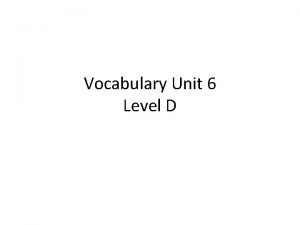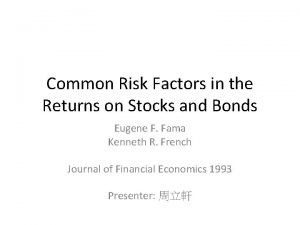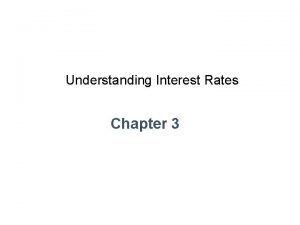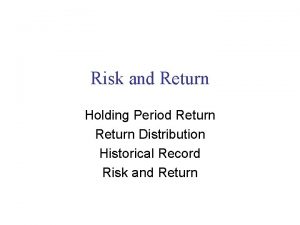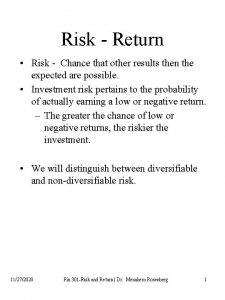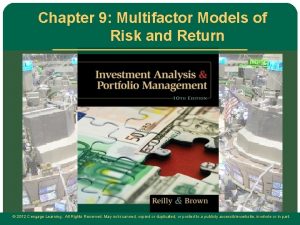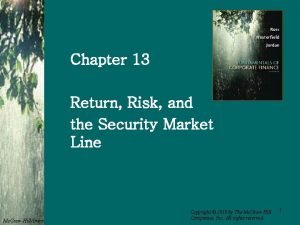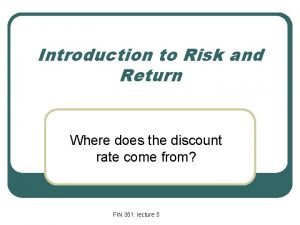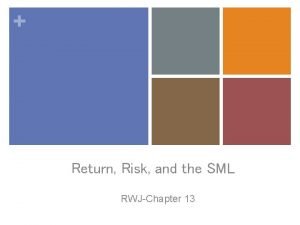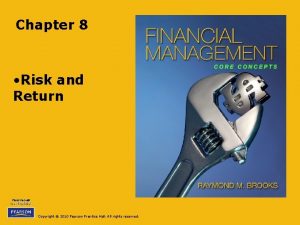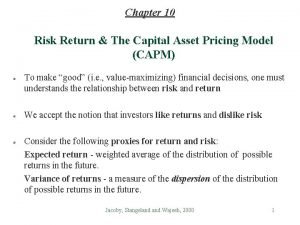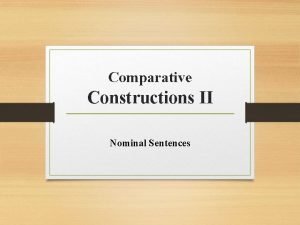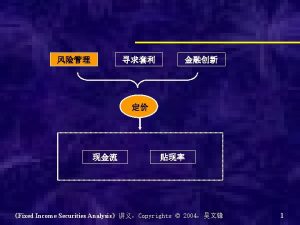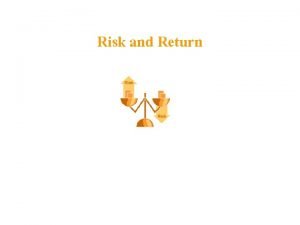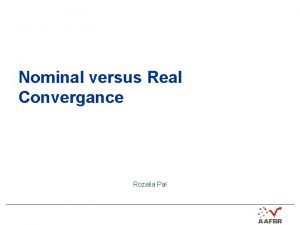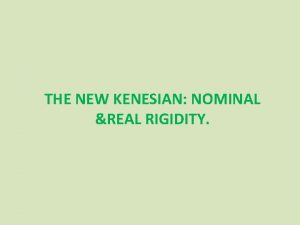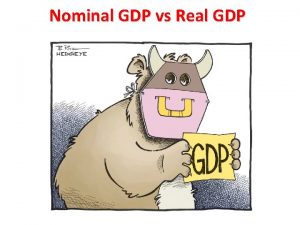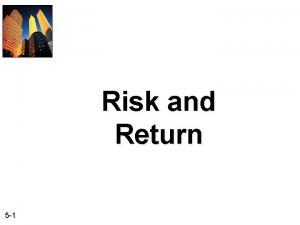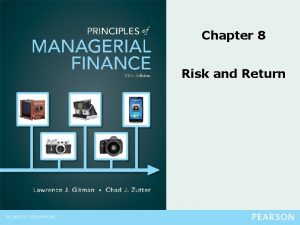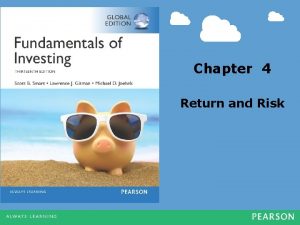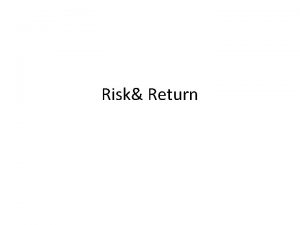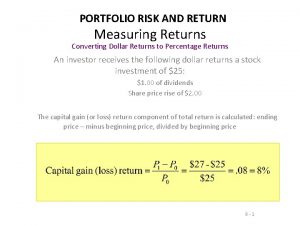Return and Risk Returns Nominal vs Real Holding

















- Slides: 17

Return and Risk Returns – Nominal vs. Real Holding Period Return Multi-period Return Distribution Historical Record Risk and Return

Real vs. Nominal Rate q Real vs. Nominal Rate – Exact Calculation: q q q R: nominal interest rate (in monetary terms) r: real interest rate (in purchasing powers) i: inflation rate q Approximation (low inflation): q Example Ø 8% nominal rate, 5% inflation, real rate? Investments 7 q Exact: q Approximation: 2

Single Period Return q Holding Period Return: Ø Percentage gain during a period q q q P 0 P 1+D 1 t=0 t=1 HPR: holding period return P 0: beginning price P 1: ending price D 1: cash dividend Example q Investments 7 You bought a stock at $20. A year later, the stock price appreciates to $24. You also receive a cash dividend of $1 during the year. What’s the HPR? 3

Multi-period Return: APR vs. EAR q q APR – arithmetic average EAR – geometric average Ø Ø q T: length of a holding period (in years) HPR: holding period return APR and EAR relationship Investments 7 4

Multi-period Return - Examples q Example 1 Ø q 25 -year zero-coupon Treasury Bond Example 2 Ø What’s the APR and EAR if monthly return is 1% Investments 7 5

Return (Probability) Distribution q Moments of probability distribution Ø Ø Ø q Mean: measure of central tendency Variance or Standard Deviation (SD): measure of dispersion – measures RISK Median: measure of half population point Return Distribution Ø Describe frequency of returns falling to different levels Investments 7 6

Measuring Risk and Return You decide to invest in IBM, what will be your return over next year? q Scenario Analysis vs. Historical Record q Ø Scenario Analysis: Ø Historical Record: q What time period historical data should you use? Ø Investments 7 What data is relevant now? 1930 s? 1980 s? 2008? 7

Risk and Return Measures q Scenario Analysis and Probability Distribution Ø Expected Return Ø Return Variance Ø Standard Deviation (“Risk”) Investments 7 8

Risk and Return Measures q More Numerical Analysis Ø Using Excel Investments 7 9

Risk and Return Measures q Example Ø Ø Current stock price $23. 50. Forecast by analysts: q q q Ø optimistic analysts (7): $35 target and $4. 4 dividend neutral analysts (6): $27 target and $4 dividend pessimistic analysts (7): $15 target and $4 dividend Expected HPR? Standard Deviation? Investments 7 10

Accounting for Risk - Sharpe Ratio q Reward-to-Variability (Sharpe) Ratio Ø Ø Ø q E[r] – rf - Risk Premium r – rf - Excess Return rf - Risk-free rate, i. e. 1 month T-Bill rate Sharpe ratio for a portfolio: or Investments 7 11

Risk and Horizon q S&P 500 Returns 1970 – 2005 Daily Mean 0. 0341% Std. Dev. 1. 0001% q Yearly Mean 8. 9526% Std. Dev. 15. 4574% How do they compare* ? Ø Ø Mean Std. Dev. 0. 0341*260 = 8. 866% 1. 0001*260 = 260. 026% SURPRISED? ? ? * There is approximately 260 working days in a year Investments 7 12

Consecutive Returns It is accepted that stock returns are independent across time q q q Consider 260 days of returns r 1, …, r 260 Means: E(ryear) = E(r 1) + … + E(r 260) Variances vs. Standard Deviations: s(ryear) ¹ s(r 1) + … + s(r 260) Var(ryear) = Var(r 1) + … + Var(r 260) Investments 7 13

Consecutive Returns Volatility Daily volatility seems to be disproportionately huge! q S&P 500 Calculations Ø Ø Ø Daily: Var(rday) = 1. 0001^2 = 1. 0002001 Yearly: Var(ryear) = 1. 0002001*260 = 260. 052 Yearly: Bottom line: Short-term risks are big, but they “cancel out” in the long run! q Investments 7 14

Normality Assumption q The normality assumption for simple returns is reasonable if the horizon is not too short (less than a month) or too long (decades). Investments 7 15

Other Measures of Risk - Value at Risk q q Term coined at J. P. Morgan in late 1980 s Alternative risk measurement to variance, focusing on the potential for large losses • Va. R statements are typically made in $ and pertain to a particular investment horizon, e. g. –“Under normal market conditions, the most the portfolio can lose over a month is $2. 5 million at the 95% confidence level” Investments 7 16

Wrap-up What is the holding period return? q What are the major ways of calculating multi-period returns? q What are the important moments of a probability distribution? q How do we measure risk and return? q Investments 7 17
 Nominal interest rate equation
Nominal interest rate equation Holding fast; holding together firmly; persistent
Holding fast; holding together firmly; persistent Common risk factors in the returns on stocks and bonds
Common risk factors in the returns on stocks and bonds Bond future value formula
Bond future value formula Real rate of return formula
Real rate of return formula Market risk assessment
Market risk assessment Chapter 10 basics of saving and investing
Chapter 10 basics of saving and investing Risk and return
Risk and return Risk and return
Risk and return Risk and return
Risk and return Multifactor models of risk and return
Multifactor models of risk and return Financial management chapter 8 risk and return
Financial management chapter 8 risk and return Chapter 13 return risk and the security market line
Chapter 13 return risk and the security market line Introduction to risk and return
Introduction to risk and return Risk and return
Risk and return Chapter 8 risk and rates of return problem solutions
Chapter 8 risk and rates of return problem solutions Calculate expected portfolio return
Calculate expected portfolio return Contoh soal risk and return
Contoh soal risk and return

